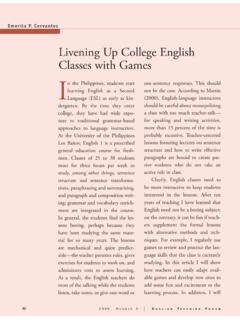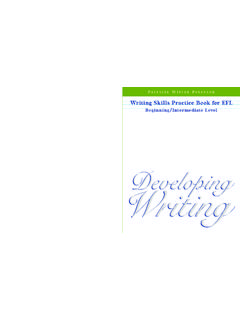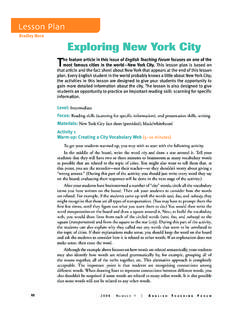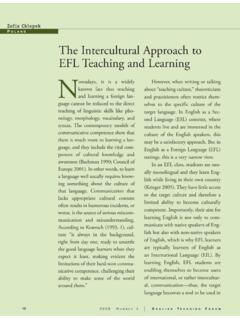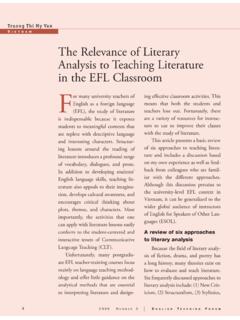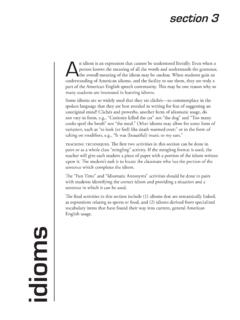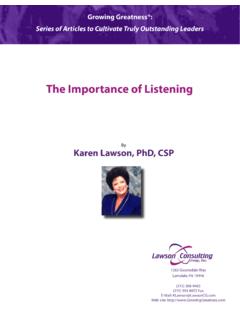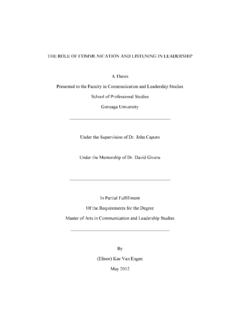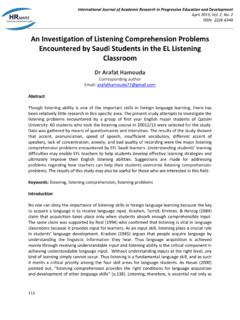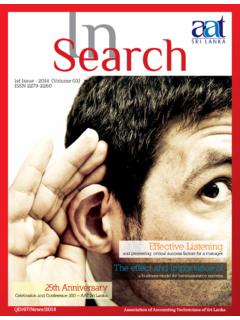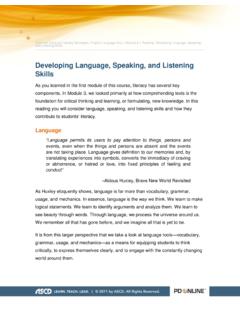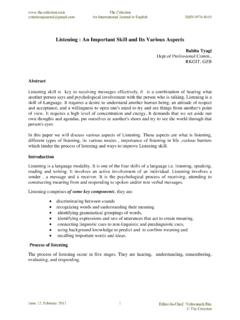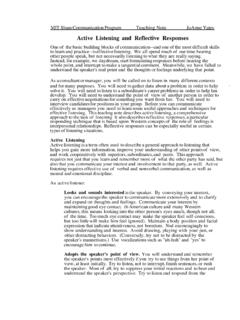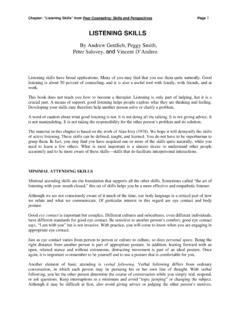Transcription of T u r k e y Teaching Listening Skills to Young Learners ...
1 102 0 1 2 NU M B E R 3 | En g l i s h TEac h i n g Fo r u mTurkeyMustafa S evikTeaching Listening Skills to Young Learners through Listen and Do SongsIf it s true that Listening Skills are the most important outcomes of early language Teaching (Demirel 2004), that explains the constant demand for methods that successfully improve Listening Skills of Learners . Songs can be one of the most enjoy-able ways to practice and develop lis-tening Skills . Any syllabus designed for Teaching English as a Second/Foreign Language (ESL/EFL) to Young learn-ers (YLs) typically contains songs, chants, and rhymes (Bourke 2006). Musical expression is an essential part of the human experience, and chil-dren respond enthusiastically to songs and welcome them. Klein (2005) argues that teach-ing YLs is different from Teaching adults.
2 YLs tend to change their mood every other minute, and they find it extremely difficult to sit still. On the other hand, children show greater motivation than adults to do things that appeal to them. It therefore helps if the teacher is inventive and selects a wide variety of interesting activities, especially with purpose of this article is two-fold: I will first provide a theoretical discussion about Listening Skills and YLs, and about songs and YLs in gen-eral; second, I will provide a sample les-son for what can be called Listen and Do songs for YLs at the beginning level. These are the songs to which stu-dents physically respond by perform-ing an action ( , a song contains the words wake up, and whenever students hear wake up they perform an action, such as raising their hands).
3 Teachers around the world can apply this lesson to songs of their own choice to make students active participants in the Listening activity from start to fin-ish. Following the lesson plan is a short list of online song resources for teach-ing Young ESL/EFL Skills and Young learnersListening is the receptive use of language, and since the goal is to make sense of the speech, the focus is on meaning rather than language (Cam-eron 2001). Sar oban (1999) states 11EN G L I S H TE A C H I N G FO R U M | Nu m b e r 3 2 0 1 2that Listening is the ability to identify and understand what others are saying. For learn-ers, Listening is how spoken language becomes input ( , it is the first stage of learning a new language). In the classroom, this happens by Listening to the teacher, a CD, or other Learners .
4 It is the process of interpreting mes-sages what people theories of speech perception portray listeners as having very different roles. In the first view, listeners play a passive role and simply recognize and decode sounds, and in the second view, listeners play an active role and perceive sounds by accessing internal articulation rules to decode speech (Crystal 1997). Whether speech perception is active or passive, or a combination of both, Phillips (1993) says that Listening tasks are extremely important in the primary school setting, providing a rich source of language data from which children begin to build up their own ideas of how the foreign language works. This knowledge is a rich source that YLs draw on to produce language.
5 Listening is the initial stage in first and second language acquisition. According to Sharpe (2001), the promotion of children s speaking and Listening Skills lies at the heart of effective learning in all subjects of the pri-mary curriculum. Therefore, ESL/EFL teach-ers have to make the development of children s Listening Skills a key aim of primary Teaching and equip them with the best strategies for effective Listening . Linse (2005) also considers the teach-ing of Listening Skills as foundational to the development of other language Skills . We should, however, be aware that any kind of Listening comprehension activity needs to be well guided with clear aims. To this end, Ur (1996) argues that a Listening purpose should be provided in the definition of a pre-set task.
6 The definition of a purpose (a defined goal, as in the wake up example) enables the listener to listen selectively for significant informa-tion. Providing the students with some idea of what they are going to hear and what they are asked to do with it helps them to succeed in the task; it also raises motivation and interest. The fact that Learners are active during the lis-tening, rather than waiting until the end to do something, keeps the Learners busy and helps prevent and Young learnersThe most prominent features of songs that reinforce language acquisition include their rhythmic and repetitive nature and the joy that the association between melody and content brings to the learning activity. Chil-dren have a keen awareness of rhythm, and they have not yet experienced the anxiety that can accompany learning a second language (Krashen 1981).
7 Therefore, songs are consid-ered to be a sine qua non of Teaching ESL/EFL to YLs. I feel that among the many advantages of using songs in YL ESL/EFL classrooms, the most striking ones are the are key to primary practice Most primary school teachers generally use songs as a Teaching technique, and Cam-eron (2001) claims that the use of songs and rhymes is also important for YLs in foreign language classrooms. Likewise, John-stone (2002) claims that teachers of YLs may make an important contribution to children s early language education by introducing their classes to recorded songs. Demirel (2004) makes the strongest claim when he argues that the most effective way to teach Listening comprehension, pronunciation, and dictation to YLs is through Teaching songs. Songs create a safe and natural classroom ethosAccording to Cullen (1998, 1999), songs are significant Teaching tools in Teaching ESL/EFL because, as most teachers find out, students love Listening to music in the language class-room and they often hold strong views about music.
8 This affinity with music makes songs vital tools to create a safe and natural class-room ethos and to overcome feelings of shy-ness and hesitation on the part of the of their limited attention span, YLs need a variety of activities. YLs are often shy, and they should join in classroom activi-ties when they feel ready rather than when the teacher demands an opportunity that songs create (Djigunovich and Vilke 2000). The learning characteristics of YLs also reveal a need to develop a strong emotional attach-ment to their teacher. Listen and Do songs support this attachment since the students and the teacher are physically involved in doing the same actions; that is, they share a 122 0 1 2 NU M B E R 3 | En g l i s h TEac h i n g Fo r u mcommon experience.
9 The students education, including language education, is a process in which they should be encouraged to contrib-ute physically, emotionally, and intellectu-ally. This type of learning environment is best achieved when the teacher creates a safe, non-threatening context within which Learners can play with provide opportunities for repetition and practiceSongs provide excellent opportunities for repetition and practice that might otherwise be tedious. Repetition of language is pleasur-able such as repeating choruses, or singing cumulative songs where each verse borrows words from a previous verse ( , The Twelve Days of Christmas ). This repetition, most often accompanied by physical actions, helps learning and in turn leads to familiar-ity so that children feel comfortable with the foreign language (Rumley 1999).
10 In addition, as argued by Sharpe (2001), by singing songs pupils gradually internalize the structures and patterns of the foreign language as well as the specific language items that the teacher wants them to provide opportunities for real language useAccording to Sharpe (2001), songs provide an occasion for real language use in a fun and enjoyable situation. She claims that singing is a vital part of the life of a Young child, inside and outside the school, and incorporating the foreign language into this fundamental activ-ity is another way of normalizing it. Young children readily imitate sounds and often pleasurably associate singing and playing with rhythms and rhymes from an early (2001) believes that the follow-ing three patterns emerge from the research on why songs are valuable in the ESL/EFL classroom:1.

